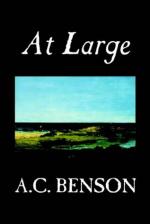Now it is useless to dictate to others the aims and methods of travel: each must follow his own taste. To myself the acquisition of knowledge and information is in these matters an entirely negligible thing. To me the one and supreme object is the gathering of a gallery of pictures; and yet that is not a definite object either, for the whimsical and stubborn spirit refuses to be bound by any regulations in the matter. It will garner up with the most poignant care a single vignette, a tiny detail. I see, as I write, the vision of a great golden-grey carp swimming lazily in the clear pool of Arethusa, the carpet of mesembryanthemum that, for some fancy of its own, chose to involve the whole of a railway viaduct with its flaunting magenta flowers and its fleshy leaves. I see the edge of the sea, near Syracuse, rimmed with a line of the intensest yellow, and I hear the voice of a guide explaining that it was caused by the breaking up of a stranded orange-boat, so that the waves for many hundred yards threw up on the beach a wrack of fruit; yet the same wilful and perverse mind will stand impenetrably dumb and blind before the noblest and sweetest prospect, and decline to receive any impression at all. What is perhaps the oddest characteristic of the tricksy spirit is that it often chooses moments of intense discomfort and fatigue to master some scene, and take its indelible picture. I suppose that the reason of this is that the mind makes, at such moments, a vigorous effort to protest against the tyranny of the vile body, and to distract itself from instant cares.
But another man may travel for archaeological or even statistical reasons. He may wish, like Ulysses, to study “manners, councils, customs, governments.” He may be preoccupied with questions of architectural style or periods of sculpture. I have a friend who takes up at intervals the study of the pictures of a particular master, and will take endless trouble and undergo incredible discomfort, in order to see the vilest daubs, if only he can make his list complete, and say that he has seen all the reputed works of the master. This instinct is, I believe, nothing but the survival of the childish instinct for collecting, and though I can reluctantly admire any man who spares no trouble to gain an end, the motive is dark and unintelligible to me.
There are some travellers, like Dean Stanley, who drift from the appreciation of natural scenery into the pursuit of historical associations. The story of Stanley as a boy, when he had his first sight of the snowy Alps on the horizon, always delights me. He danced about saying, “Oh, what shall I do, what shall I do?” But, in later days, Stanley would not go a mile to see a view, while he would travel all night to see a few stones of a ruin, jutting out of a farmyard wall, if only there was some human and historical tradition connected with the place. I do not myself understand that. I should not wish to see Etna merely because Empedocles is supposed




